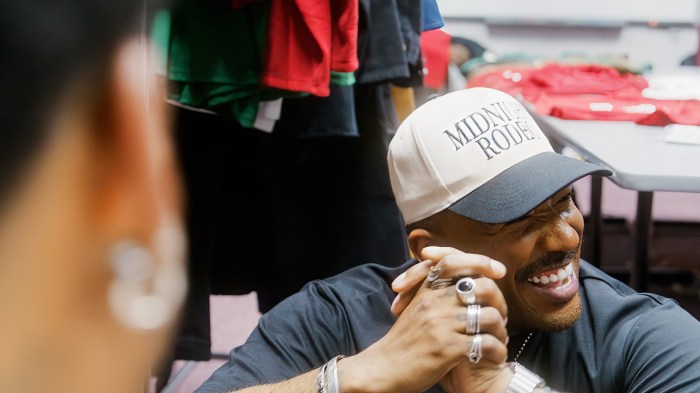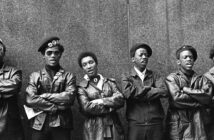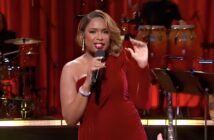RICHMOND, Virginia — As we sit in a building on the campus of Virginia Union University, Dex Robinson has a box of food from Bojangles restaurant in front of him.
The 38-year-old is dressed like only one of the top stylists in sports fashion can be seen. Loose brown slacks with cargo pockets on each pant leg sit under a white thermal shirt that stops near the top of his hips. A few chains hang from his neck and silver rings line up evenly across all his fingers. A monochromatic brown N.E.R.D. hat sits almost firmly atop his head.
But the centerpiece of this outfit is a furry pink jacket that, when worn, fits almost perfectly over the thermal. Mind you, it’s an unusually hot, 90-degree day in late October. But this is Robinson’s uniform. What he wears is representative of who he is.
So donning this look for a homecoming alumni panel earlier today at the 158-year-old historically Black university is all about how people receive the designer and stylist for some of the biggest athletes in sports.
“So even today it’s hot, but I have that pink furry thing on, and literally when I’m seeing people, I don’t know them, but I can see them say, ‘Who is he?’ They want to know who I am,” Robinson said.
“Before I got on the stage or whatever, they will probably think I’m somebody regardless. And before I was somebody, I wanted people to think that.”
Brandon ‘Jinx’ Jenkins celebrates the brotherhood of Morehouse men with his Nike Yardrunners collaboration Read now
After graduating from Virginia Union in 2009, Robinson hopped right into the fashion scene, eventually joining a young class of Black designers shaping men’s and womenswear in sports. He’s styled New York Knicks forward Mikal Bridges, Seattle Seahawks receiver DK Metcalf and Philadelphia Eagles quarterback Jalen Hurts. He started a clothing brand, Diallo, with New York Jets quarterback and fellow Virginia native Tyrod Taylor. Of Complex magazine’s top 25 best dressed athletes of 2024, Robinson has either styled or had his Diallo clothing worn by four athletes listed in the top 10.
His success in the industry led him back to Richmond last month to not only showcase Diallo in an on-campus fashion show but also debut his new sneaker collaboration with Nike’s Yardrunners initiative, which is focused on historically Black colleges and universities: an all-black Air Force 1 with black fur (the school’s nickname is the Panthers), maroon laces and a Virginia Union logo pendant.
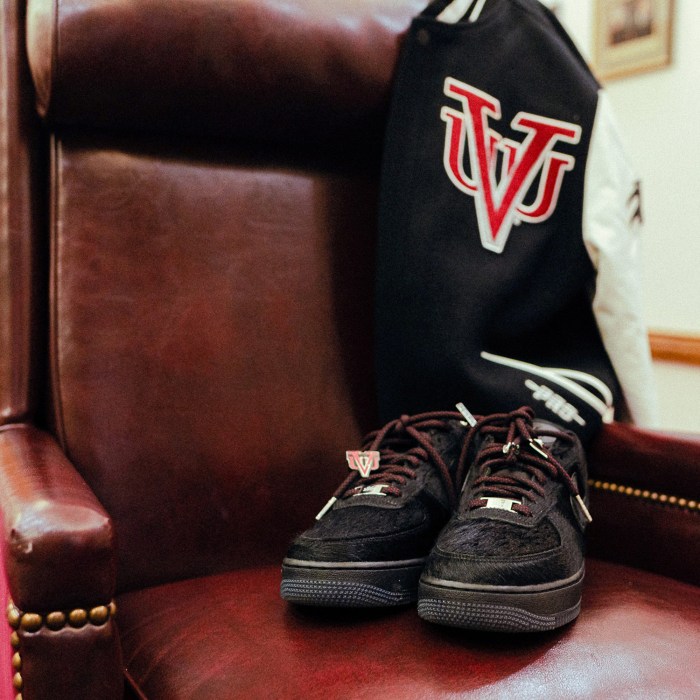 Stylist Dex Robinson’s Virginia Union University varsity jacket and Nike/HBCU sneaker collaboration.
Stylist Dex Robinson’s Virginia Union University varsity jacket and Nike/HBCU sneaker collaboration.
Larryl Pitts for Andscape
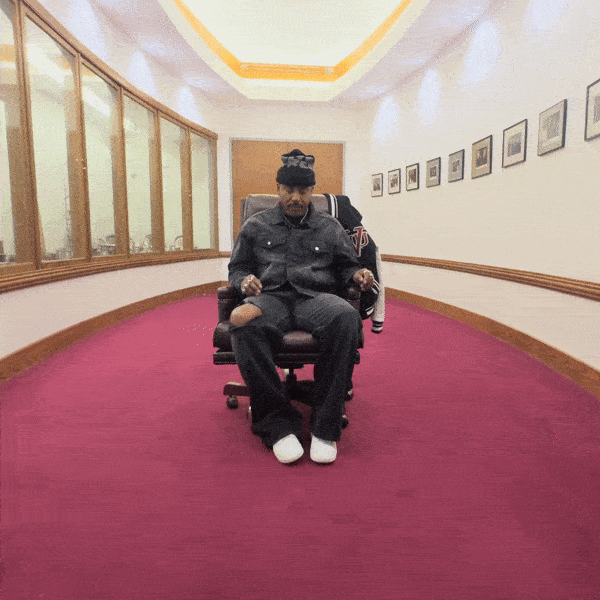 After graduating from Virginia Union in 2009, stylist Dex Robinson quickly moved into the fashion scene.
After graduating from Virginia Union in 2009, stylist Dex Robinson quickly moved into the fashion scene.
Larryl Pitts for Andscape
Robinson’s dad is from New York, and his mom is from Washington. He was born in Philadelphia and raised in Richmond, Virginia, the oldest of four brothers and one sister. “It’s like WWF in there,” he said. Being the oldest of so many other younger siblings — there’s a six-year difference between him and his eldest brother — forced Robinson to have to develop adult skills sooner than a teenager is expected to. He had to cook, clean, get his brothers and sister ready for school, and even learn to drive (in Mississippi, where the family briefly moved for Robinson’s stepfather’s job, a 14-year-old can get a temporary learner’s permit).
“You just had to grow up a little quicker,” he said.
Richmond rightfully gets a reputation for being inhospitable to Black people: It’s a former capital of the Confederacy and, until 2021, had an entire avenue in the city dedicated to Confederate veterans. “Virginia’s traditionally racist,” Robinson said.
But Richmond is also where free and formerly enslaved Black people built a vibrant financial economy, Jackson Ward, in the early 20th century, not unlike the Greenwood District in Tulsa, Oklahoma (like Greenwood, Jackson Ward in Richmond was nicknamed the “Black Wall Street”). But, among other things, a highway project in the 1950s ran directly through the middle of Jackson Ward, displacing thousands of Black families, homes and businesses and leading to stark socioeconomic differences for Black and white residents that persist today.
This is the Richmond that Robinson grew up in, where many have to live with what Robinson calls a “making-a-way-out-of-no-way” mentality. He believes the most creative people in the world are that way because creativity is born from a lack of resources. Robinson’s eyes were trained in the aisles of affordably priced Marshall’s and JCPenney, as opposed to luxury brands Bottega Veneta and Fear of God.
“Being resourceful and finding beauty in things that aren’t stereotypically beautiful is the most Virginia thing in me,” he said.
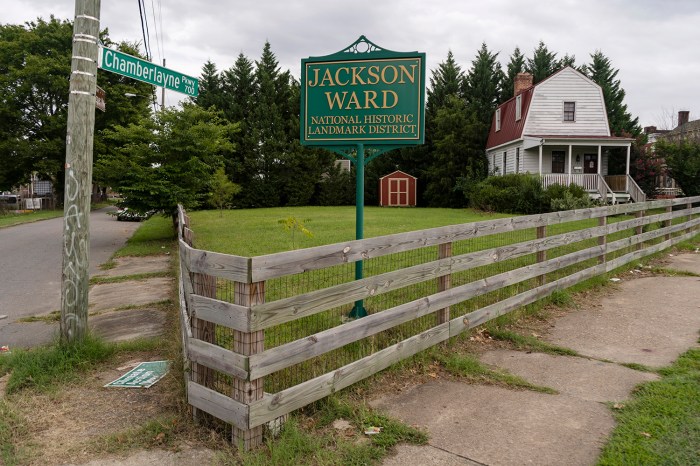 Photo of historic marker at the intersection of Chamberlayne Parkway in Jackson Ward in Richmond, Virginia, on Aug. 11, 2022.
Photo of historic marker at the intersection of Chamberlayne Parkway in Jackson Ward in Richmond, Virginia, on Aug. 11, 2022.
Darlos Bernate for The Washington Post via Getty Images
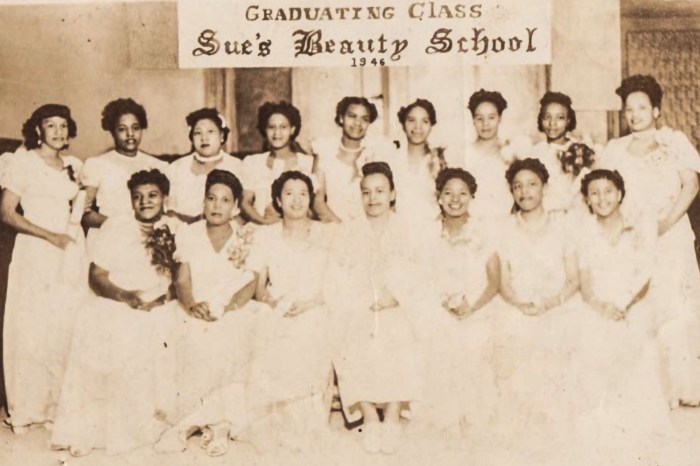 Stylist Dex Robinson’s great-great-grandmother, Sue Edwards (bottom row, center), ran one of the first Black-owned beauty schools in the state.
Stylist Dex Robinson’s great-great-grandmother, Sue Edwards (bottom row, center), ran one of the first Black-owned beauty schools in the state.
Dex Robinson
After high school, Robinson had no plans to go to college. His college admission test scores were average, but his GPA was worse. Because he was a class clown, Robinson spent a lot of time in the office of his guidance counselor, Michael Oliver, an alum of Virginia Union who always had school swag on his walls.
Oliver sold the school as a place where Robinson could chase his fashion dreams while remaining close to home in Richmond. Attending an HBCU meant being surrounded by people with similar backgrounds to Robinson’s.
“It just feels different when you’re around people that share the same culture, people that’s out there striving for the same end goal, which is to get that college degree,” Oliver said.
Although many of Robinson’s friends from home went to HBCUs such as North Carolina Central, Fayetteville State and Virginia State, he didn’t have much of a personal connection to Black colleges. An uncle played basketball at Virginia Union and his maternal grandmother, Deborah Frye, attended the seminary there as well, though that was a separate institution from the university.
“So it wasn’t even for a Black experience or anything like that, that’s just what I knew,” Robinson said while rifling through dozens of Diallo products hanging on a clothes rack for student models at that weekend’s runway show.
Robinson will tell you that he didn’t dress anything like the kids around him growing up in the early 2000s: baggy jeans, throwback NBA jerseys, tall tees. He preferred the fluent style of rocker Lenny Kravitz and the skater aesthetic of music producer Pharrell Williams, who is from Virginia Beach. “I’m wearing Rocawear, but I’m ironing it,” he said. “In Virginia, they look at you like you’re weird.”
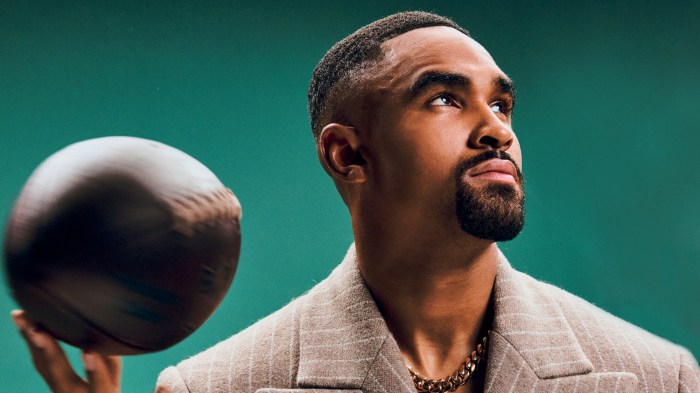 Jalen Hurts and the pursuit of perfectionRead now
Jalen Hurts and the pursuit of perfectionRead now
Robinson comes from a long line of sharp dressers and those who value their appearance. His father and uncle were professional barbers, and Robinson’s maternal great-great-grandmother, Sue Edwards, ran one of the first Black-owned beauty schools in the state. You’d always catch Grandma Sue with her hair in waves and dressed in white clothing that fit her frame.
She passed those lessons down to her granddaughter, Frye, making it a rule not to leave the house with unkempt clothes or your hair not done properly. “She taught us morals about what to wear, how to wear it,” Frye said, dressed in a red and black blazer-dress combo seen in many Black churches nationwide. “We wore fashion that matched.”
Frye, in turn, passed that message down to Robinson.
“I wanted to make sure that he’s clean, neat, matching,” Frye said.
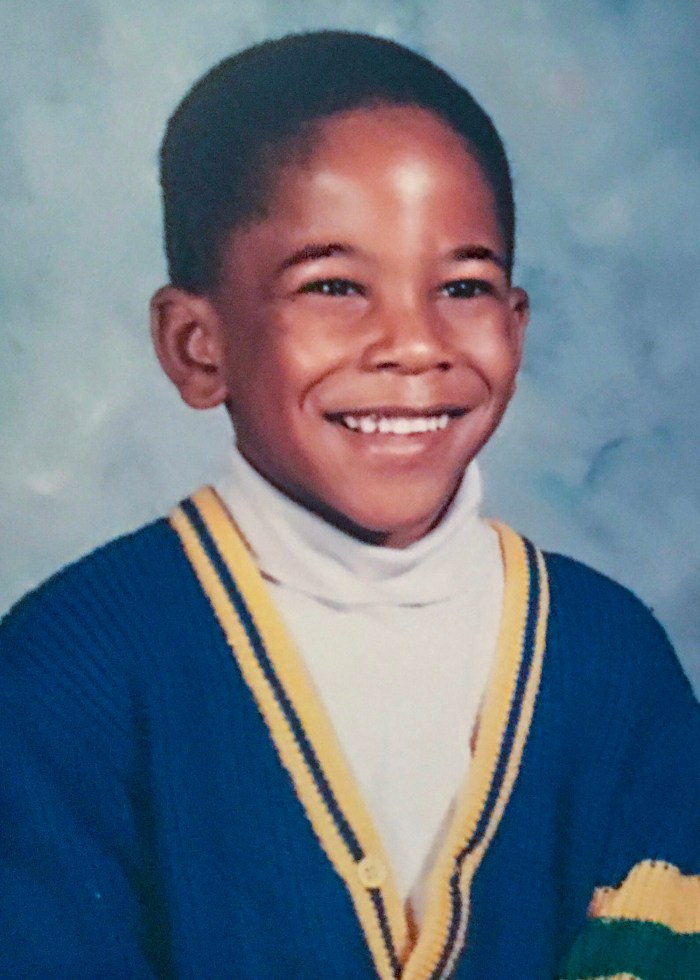 Stylist Dex Robinson grew up in Richmond, a city with stark socioeconomic differences for Black and white residents that persist today.
Stylist Dex Robinson grew up in Richmond, a city with stark socioeconomic differences for Black and white residents that persist today.
Dex Robinson
At Virginia Union, he met Black people from Chicago, St. Louis, Los Angeles and New Orleans who brought their own distinct regional style to campus. Robinson’s manager, Ricky Parker, who is from Prince George’s County, Maryland, always wore blazers and loafers at school, which stemmed from his comfort in himself and his clothes. “Pretty Ricky,” as he’s called by his friends, influenced Robinson to wear more form-fitting clothes in an era of the bigger, the better.
“This was before Jay-Z did the ‘Change Clothes’ video, this was before Kanye with the polos, so I was on campus … button-up, jeans, loafers, polos, chinos,” Parker said.
Parker, who like Robinson is a member of Kappa Alpha Psi fraternity, said Robinson is at a place of mastery in fashion where he understands the intricacies of styling and presenting.
“A lot of people are intrigued by his personal style,” Parker said. “And so it’s not like, ‘Oh, you’re heavy label-driven.’ Even when you think about the cuts or the silhouettes and the stuff he wears, where it’s like, ‘Oh, wow, this is different,’ or ‘I’ve never seen nobody wear anything like this,’ or ‘You look like somebody important.’ ”
Because of Virginia Union, Robinson developed an identity and confidence that’s unique among Black people who are celebrated and guided by other Black people at HBCUs.
“You’re feeling empowered to be who you want to be, show up how you want to show up,” Robinson said.
 How stylists are helping WNBA players elevate their dripRead now
How stylists are helping WNBA players elevate their dripRead now
After graduation, Robinson almost immediately jetted off to New York, where one of his first jobs was working for Marvet Britto at her public relations firm The Britto Agency, assisting on campaigns for singer Mariah Carey and NBA players Stephon Marbury and Shaquille O’Neal. This is where he learned branding and packaging. He later worked in the public relations sector of Public School, a streetwear brand out of New York that was founded by two former Sean John employees. “And so I merged a world so to speak because they really focused on menswear at the time,” Robinson said of his time at The Britto Agency and Public School. He later worked for denim brand G-Star (worn by Jay-Z) and as a public relations assistant for designer Andrew Buckler, handling e-commerce and internal lookbooks, a collection of images that showcase a brand’s products, style and identity.
Robinson’s foray into sports fashion started when he met Cappie Pondexter, then a guard with the New York Liberty. In 2006, Pondexter and a business partner founded 4 Season Style Management, an image consulting firm for athletes and celebrities. Robinson worked as a project manager for the company, doing editorial styling. He worked with WNBA players such as Tina Charles and Angel McCoughtry and multiple basketball players from Rutgers, where Pondexter played from 2001 to 2006.
In 2012, Robinson traveled with Pondexter to Orlando, Florida, for that year’s NBA All-Star Weekend. There, he met C.J. Miles, then a guard for the Utah Jazz, who’d heard that Robinson was dope in the style space and wanted Robinson to style him for a lookbook. This led to Robinson styling Miles and fellow NBA players Thomas Robinson and Tyshawn Taylor over the next few months, all while not technically working as a professional stylist.
“I wasn’t styling the NBA, but I styled them for the shoot,” he said. “It wasn’t the gameday arrivals or none of that s—.”
Regardless, the photos caught the attention of a friend from Virginia Union who was close friends with Tyrod Taylor, then with the Baltimore Ravens. She put the two men in touch in 2013, and Robinson eventually traveled to Taylor’s home to do an audit of his wardrobe.
“I went to his house. I was throwing stuff, being dramatic,” he said.
The budding relationship eventually blossomed, both with Taylor being one of the best-dressed athletes in all of sports. The pair eventually created their own clothing company.
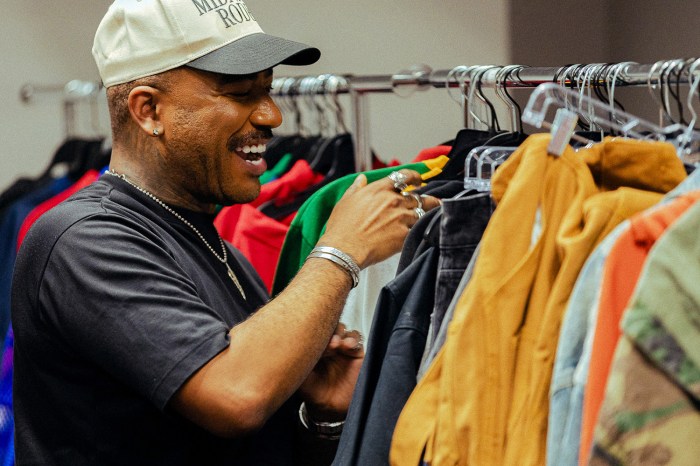 Stylist Dex Robinson sorts through collections for model fittings during the fashion show at Virginia Union University.
Stylist Dex Robinson sorts through collections for model fittings during the fashion show at Virginia Union University.
Larryl Pitts for Andscape
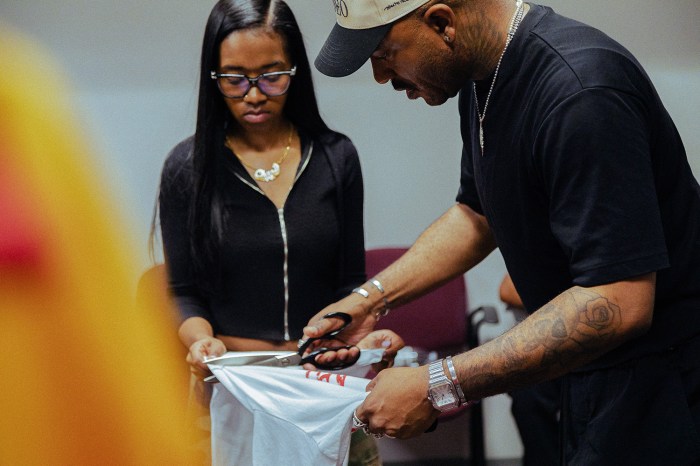 Stylist Chase Tupponce (left) helps Dex Robinson (right) repurpose a shirt for fitting.
Stylist Chase Tupponce (left) helps Dex Robinson (right) repurpose a shirt for fitting.
Larryl Pitts for Andscape
Frye raised Robinson for most of his childhood because his mother had him when she was 20 and still in college. “I’m basically my grandma’s child,” Robinson said.
The two would go to department stores, and Robinson would have free rein in the store. Even at a young age, he had a sense of how he wanted to dress and which clothes brought out his style. Frye would sit back while Robinson explored. “She can’t keep up,” he said.
His store of choice was Burlington Coat Factory. It carried brands not available in other department stores, although there might be a loose thread here or a missing button there.
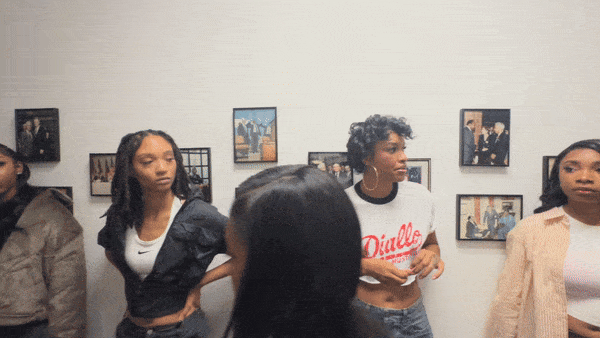 The models for the Virginia Union fashion show receive their finishing touches for Diallo and Nike.
The models for the Virginia Union fashion show receive their finishing touches for Diallo and Nike.
Larryl Pitts for Andscape
“So you can get a good mix of stuff in those places,” he said.
Robinson didn’t desire luxury brands at that age. Of course, he knew what they were and maybe wished one day to obtain them, but he couldn’t afford them, so it didn’t matter. He instead had a “relationship with the aesthetics” of luxury brands, making his outfits look luxurious without the high prices. Shein, in a sense.
“I felt like, between my eye being sharpened, to studying that stuff and being able to create it with a lower budget and confidence, I felt like people would think that it is what it ain’t,” Robinson said.
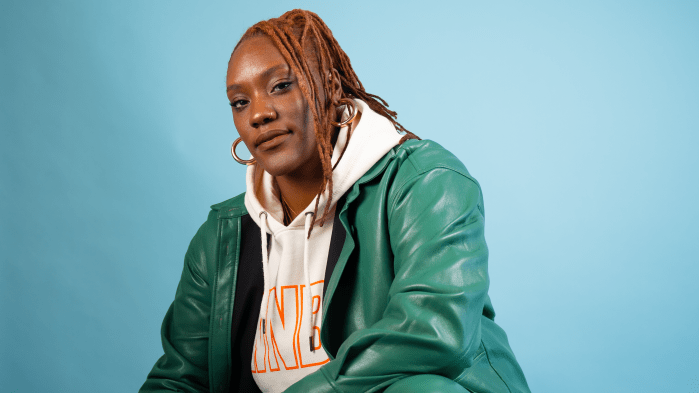 Meet the Black woman designing the coolest WNBA apparelRead now
Meet the Black woman designing the coolest WNBA apparelRead now
That confidence stems from Robinson putting thought and consideration into his presentation. Coming from nothing has all its societal stigmas, so in his mind, the way he dressed determined how people would receive and treat him as a Black man.
“I realized once I had dressier stuff, maybe they’d want to shake my hand instead of dap me up,” Robinson said.
Robinson is a master at layering his clothes. He tends to pair two tops, sometimes even a third, with the colors (white, mustard, light blue) popping off one another. Each shirt is normally cropped to his waistline. His bottoms are loose-fitting with flared pant legs. You can find him in Air Force 1s or heeled boots. He usually wears a hat on his closely cropped haircut.
He’s watched as trends have come and gone in sports. In the early 2000s, baggy bottoms and tall tees were the unofficial uniforms of the NBA and NFL. Chains and earrings were the key accessories, and a hat was necessary, even for those with pristine hairlines. “It was cool,” Robinson said. “Now I look back and I’m like, ‘Yikes.’ ” But that all started to change around 2010, when trends shifted to more preppy apparel (casual tops, tighter fitting bottoms, non-prescription eyeglasses, for some reason) and business suits. These days, gameday tunnel walks mirror runways in New York and Milan with sleeveless tops, skirts, or pink sweaters whose sleeves are so long they nearly touch the ground.
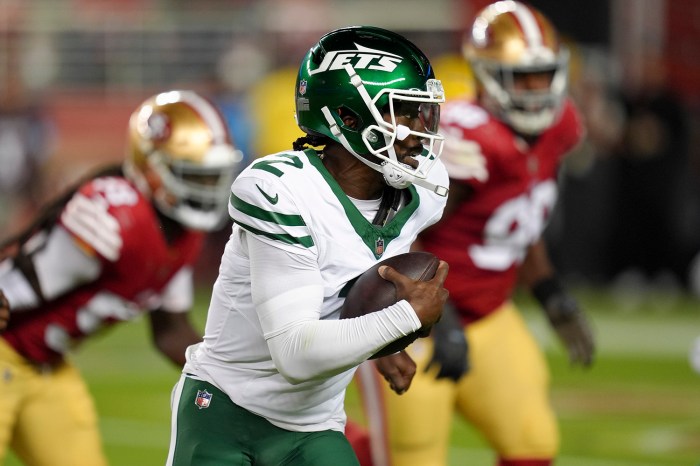 New York Jets quarterback Tyrod Taylor runs the ball during a game against the San Francisco 49ers on Sept. 9 in Santa Clara, California.
New York Jets quarterback Tyrod Taylor runs the ball during a game against the San Francisco 49ers on Sept. 9 in Santa Clara, California.
Ben Liebenberg/AP Photo
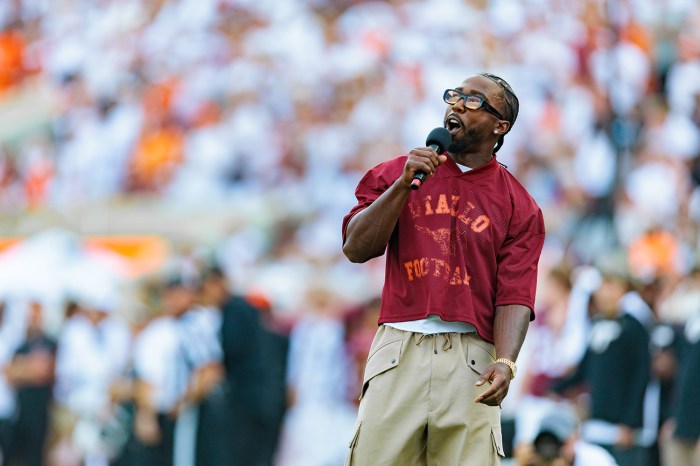 Tyrod Taylor speaks to the crowd during a game between the Virginia Tech Hokies and the Rutgers Scarlet Knights at Lane Stadium on Sept. 21 in Blacksburg, Virginia.
Tyrod Taylor speaks to the crowd during a game between the Virginia Tech Hokies and the Rutgers Scarlet Knights at Lane Stadium on Sept. 21 in Blacksburg, Virginia.
Ryan Hunt/Getty Images
For athletes, size is an issue as well. The fashion industry has historically been built on tall and skinny; “heroin chic” was a style for many years. Athletes, though, have naturally wider thighs — and in the case of hockey players, bigger butts — than most people, so fashionable clothes weren’t tailored to them.
“For the most part, at the time they weren’t making these sizes and samples,” Robinson said.
He points out that, in the past, men wore their pants higher on their natural waistline as opposed to right on their hips. Due to that, jacket and top silhouettes were shorter compared to the more modern look of shirts going past the pelvis. When styling Hurts for an Andscape cover story this summer, Robinson dressed him in a light brown, looser-fitting suit with bottoms that rose just inches below Hurts’ pectorals.
“Now stuff is longer because of society, not because of tradition,” he said. “I lean more into that, and that’s how I look at proportions when I’m dressing people.”
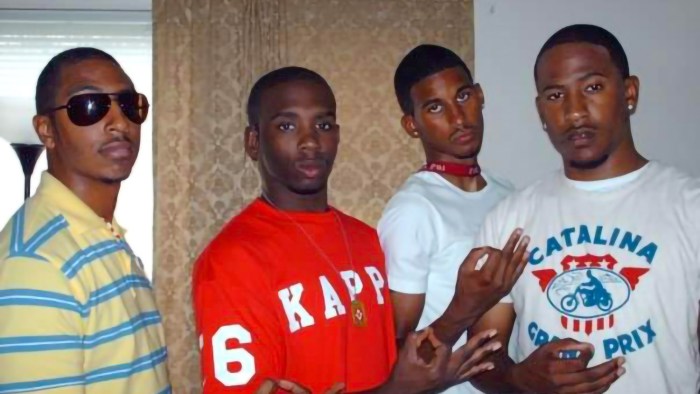 From left to right: PJ Bowie Jr., Ben Sellers and Ricky Parker with their Kappa Alpha Psi fraternity brother Dex Robinson (right) in 2006. Parker is a fellow Virginia Union alum and is Robinson’s manager.
From left to right: PJ Bowie Jr., Ben Sellers and Ricky Parker with their Kappa Alpha Psi fraternity brother Dex Robinson (right) in 2006. Parker is a fellow Virginia Union alum and is Robinson’s manager.
Dex Robinson
Fashion design, though, can be lonely for Black people. For stylists, designers, models or journalists, whiteness is the baseline and foundation of the industry. Fashion can also be very superficial, Robinson said, and even more so when it comes to its treatment of Black people and athletes. Years ago, he traveled to Paris for a show with Taylor, and the brands couldn’t accommodate Taylor in the front row, which is the first class of runway presentations. It felt like there was a quota on Black athletes: Once one or two Black athletes are seated, then there’s no more room. “They did Cam Newton, [Dwyane Wade], ‘We’re not taking no more Black athletes,’ ” Robinson said. “ ‘We got one NBA one and rest is whatever.’ ”
Sports fashion design is heavily staffed by Black people and Black women. Some of the biggest names in basketball were dressed by Rachel Johnson (LeBron James, Chris Bosh), Courtney Mays (Chris Paul, Sue Bird), Calyann Barnett (Wade) and Kesha Mcleod (P.J. Tucker, James Harden). Some of the best-dressed football players are styled by Black men, such as Jason Rembert (Odell Beckham Jr.) and Darnell Booker (Justin Jefferson). Athletes no longer just appear on the cover of Sports Illustrated but also GQ, Marie Claire and Vogue. Brands now reach out to have Robinson’s clients styled in their upcoming collections.
He has a theory about why fashion publications are more willing to work with athletes: They’re trend followers rather than trendsetters who saw one outlet work successfully with athletes and believe they can replicate it.
“People are just trend-driven and they’re not trailblazers, they’re copycats,” Robinson said.
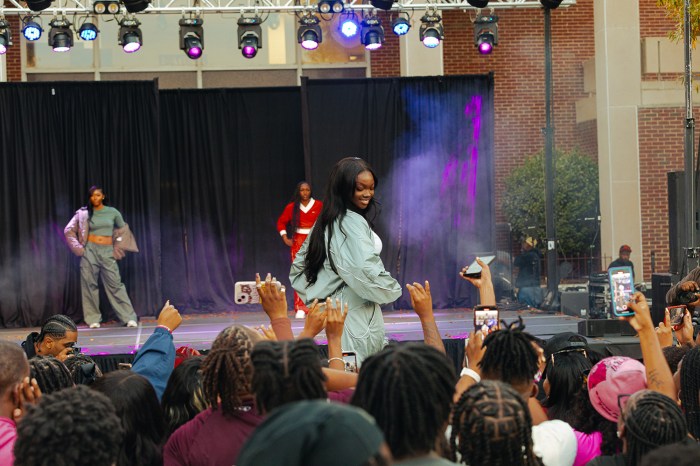 Angell Imani Garrison (center) models the Nike-Diallo collaboration during the fashion show at Virginia Union University.
Angell Imani Garrison (center) models the Nike-Diallo collaboration during the fashion show at Virginia Union University.
Larryl Pitts for Andscape
It’s why Robinson and Taylor created Diallo in 2020.
The original idea was to open a boutique shop that sold other brands, but they later pivoted into developing their own brand, using the money they otherwise would have paid for product stock from other luxury companies.
“It was only basically started because these brands wouldn’t accommodate him at shows and he’s spending his bread,” Robinson said, referring to Taylor.
The initial product was a hoodie with a cut in the neckline to accommodate chains. Now, the collection puts a luxury spin on working-class fashion. Denim jeans and jackets, overalls, two-toned, ’70s-inspired T-shirts and polos with striping on the side. Their signature piece, a mesh football jersey with “Diallo Football” written on the chest, is reminiscent of the clothing athletes wore to practice 40 or 50 years ago.
The brand, which comes from Taylor’s middle name, has been worn by everyone from hip-hop artists Offset and Metro Boomin to influencer Kayla Nicole to Oklahoma City Thunder guard Shai Gilgeous-Alexander and Dallas Wings guard Arike Ogunbowale.
“A lot of our patterns, a lot of our designs, a lot of our creations comes from someone who’s transitioning throughout their day as far as from lunch to dinner, or from breakfast to lunch, or from work to nightlife, or from being able to go throughout your day and not having to piece different outfits but being able to layer and un-layer different pieces,” Taylor said.
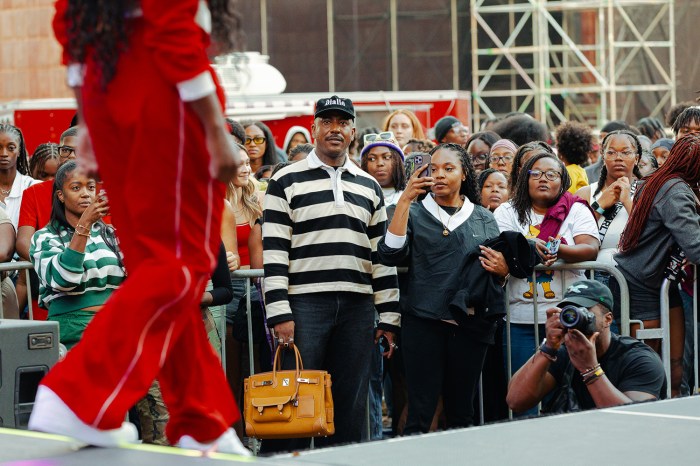 Dex Robinson (center) watches the fashion show from the pit at Virginia Union University.
Dex Robinson (center) watches the fashion show from the pit at Virginia Union University.
Larryl Pitts for Andscape
Robinson is a jovial person, always the most willing person to liven the mode in a room. He curses like actor Samuel L. Jackson, and he lacks a filter, which would make most publicists want to pull their hair out. Robinson runs an alternative Instagram account, @ihatedexrob, where he pooh-poohs all the fashion trends he hates, such as dangly cross earrings, luxury hair scarves and Yeezy Foam Runners.
Growing up, Robinson wanted to be a comedian, and idolized Martin Lawrence, Jamie Foxx, Richard Pryor and Eddie Murphy. For most of his childhood, he wore big glasses, which led to classmates calling him “Dexter,” until he discovered contacts in 10th grade. The comedy was a coping mechanism.
“I would live to make people laugh,” he said. “At first it was because I wanted to start throwing them off about talking about me and them glasses.”
But he becomes serious — or, at least, annoyed — when it comes to one thing: the profession of styling.
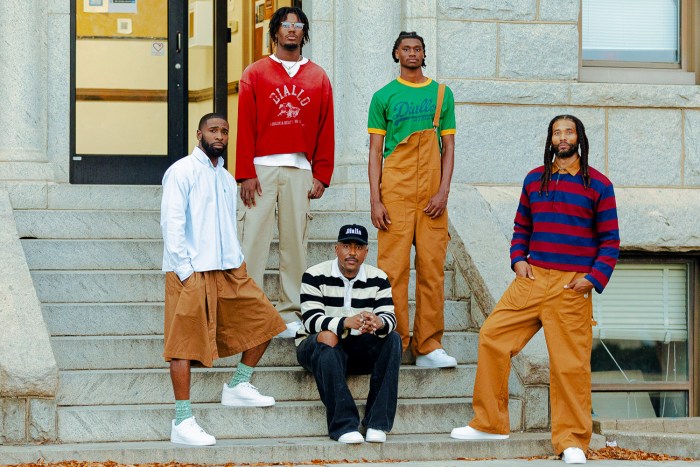 From left to right: Virginia Union students Melvin Edison, Isaiah Howard, Paul Mason and Gregory Redford model the fashion line of Dex Robinson (center).
From left to right: Virginia Union students Melvin Edison, Isaiah Howard, Paul Mason and Gregory Redford model the fashion line of Dex Robinson (center).
Larryl Pitts for Andscape
Fashion and style are subjective, but that doesn’t mean it’s a free-for-all. It’s not just about mixing this Maximilian coat with those Wales Bonner trousers and Maison Margiela shoes. It’s down to textures, patterns, fit, proportions, colors and a host of other factors. Robinson explains how, for example, a tan shirt doesn’t go with just any ol’ blue jeans, it should be blue jeans with tan undertones rather than jeans with white undertones.
He believes that many stylists go for what attracts the most attention and mistake trendy with stylish. Beyond designs, how the garments work together on the body frame matter, along with understanding the client’s wardrobe goals.
“[I’m] trying to find ways to elevate you from where you at, and then build on that,” he said. “Once I build your confidence and trust in me, then we can introduce other stuff.
“And I think a lot of people don’t assess the client for real, they just kind of assess the climate of athlete, and see what they’re doing. ‘This just came out, you’ve got to show up in this.’ No, that ain’t even them, this does not look right.”
The profession didn’t exist as recently as 20 years ago, and now sports is as synonymous with fashion as New York sports fandom is with defeat. The journey to this point took a lot of practice, researching, and shopping. It took the confidence that he developed years ago in the aisles of department stores in Richmond and New York City, a confidence that, humbly speaking, makes him believe that he’s one of, if not the best, at styling athletes.
“If you do talk about athlete styling,” he said, “Dex has to be in the conversation.”
Martenzie Johnson is a senior writer for Andscape. His favorite cinematic moment is when Django said, “Y’all want to see somethin?”
